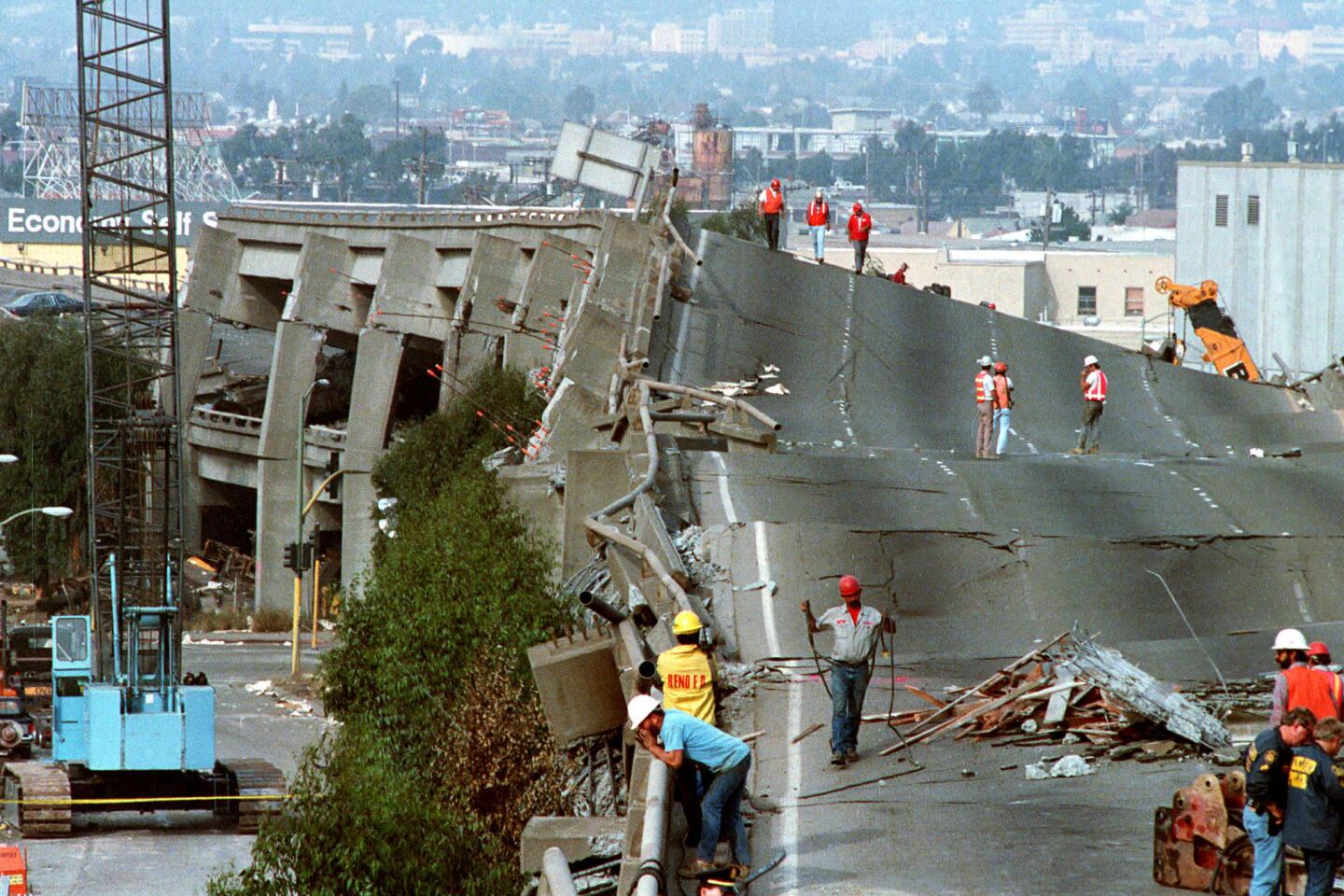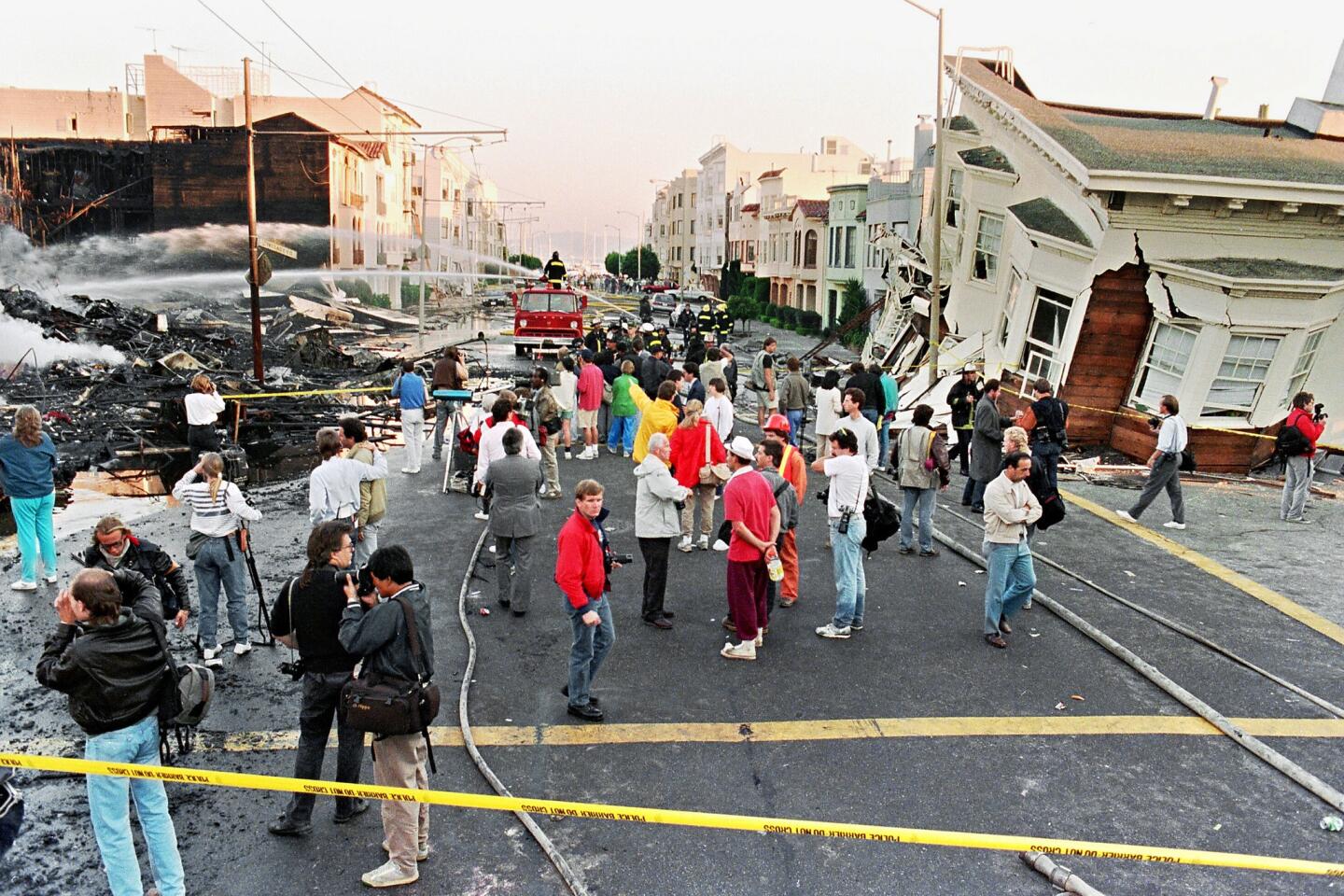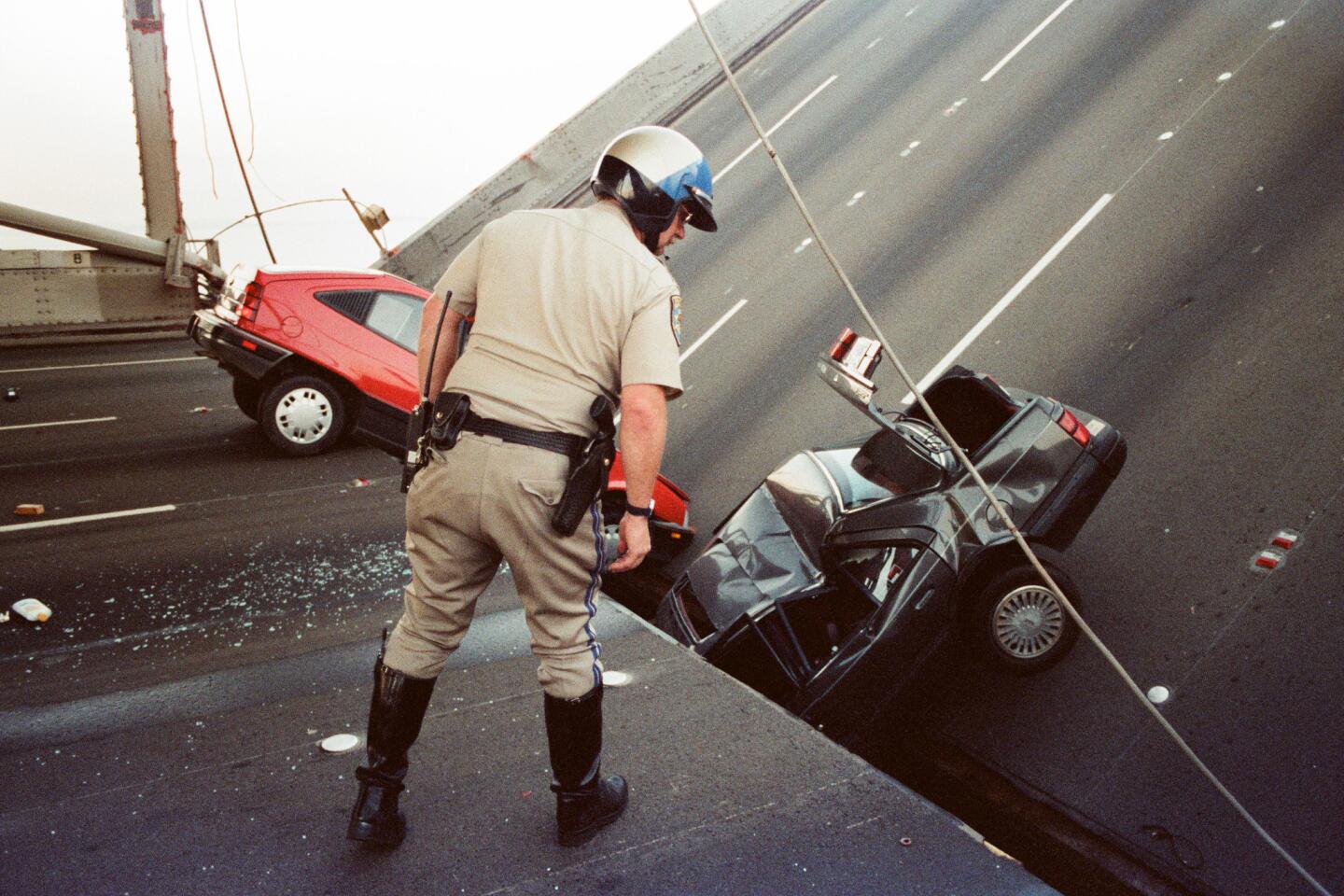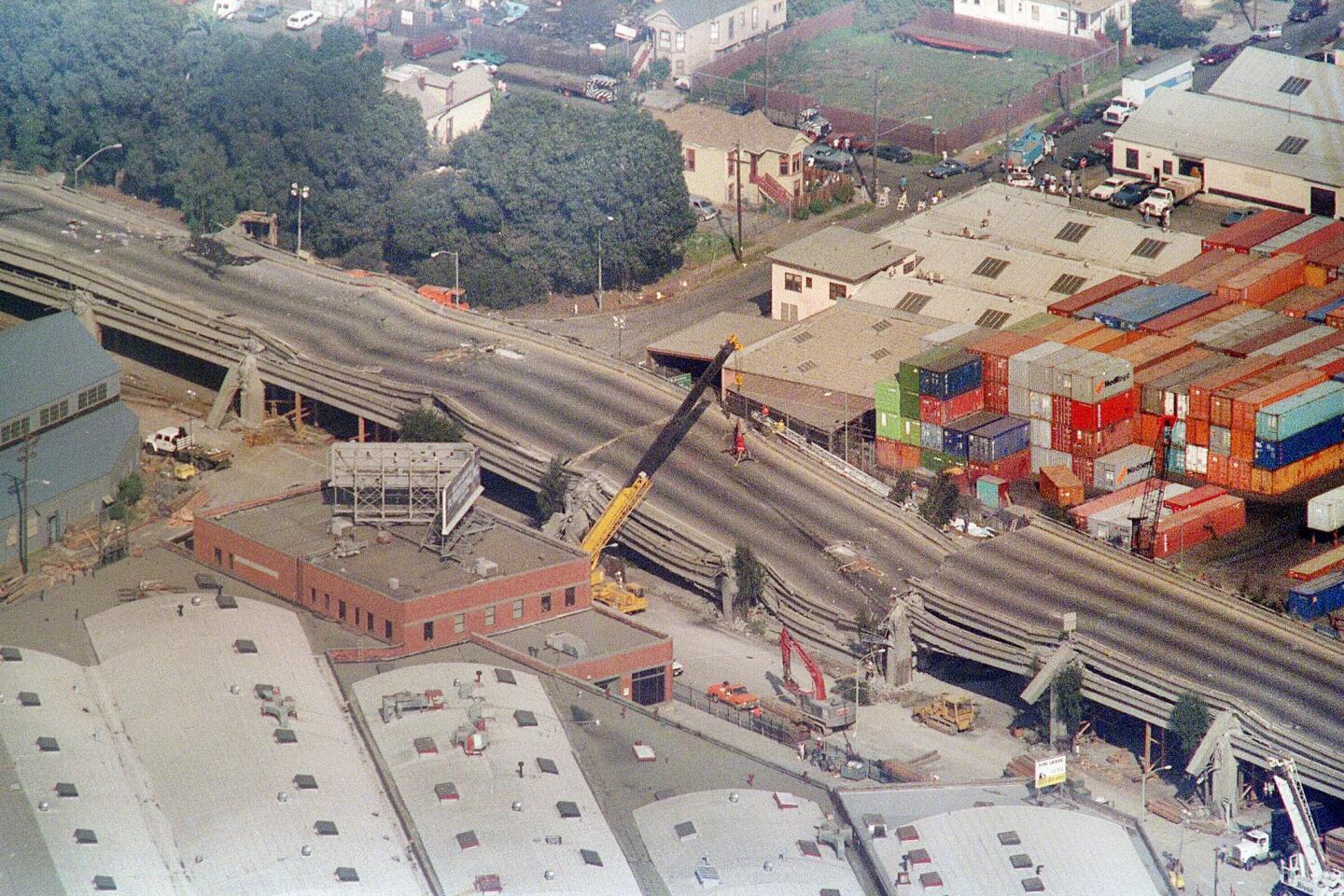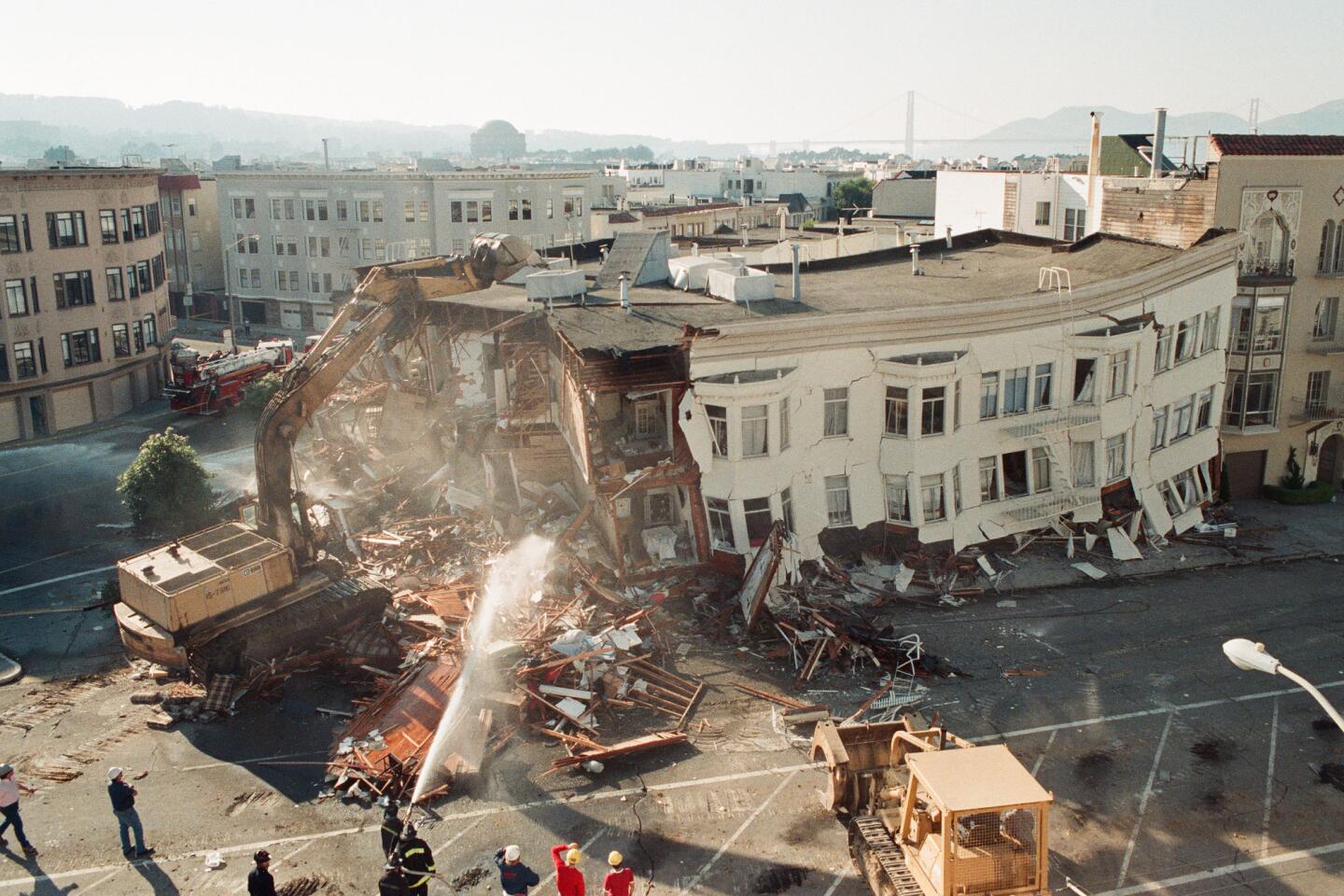From earthquake’s destruction, a new San Francisco rises three decades later

Salesforce Tower is now the tallest building in San Francisco, and its next-door neighbor, Salesforce Transit Center, aims to be a Grand Central station for the city. But the center has yet to reach its full potential — train tracks don’t yet run in
- Share via
Reporting from San Francisco — On the ground once marked by devastation, a new city is rising.
The deadly 1989 Loma Prieta earthquake battered the gritty South of Market district, damaging the Embarcadero Freeway that walled off downtown San Francisco from the bay and left city leaders with a choice: Do they repair and retrofit it, or envision something bolder?
They chose to go in a new direction. And nearly three decades after the temblor, this civic bet is beginning to take shape. The most obvious example is San Francisco’s new skyline, clustered in the South of Market area by design and now fueled by tech money.
The new $1-billion Salesforce Tower, which dwarfs any other skyscraper in the city, is getting the most attention. But it’s only part of the story. There is also a grand bus station and rooftop park set to open this summer.
Planners hope the transit center will eventually connect to Caltrain service to Silicon Valley, making it an essential hub for Bay Area commuters. Then there are a host of other nearby commercial developments powered by Silicon Valley gold.
Together, they represent a building boom the city hasn’t seen in decades as well as a significant shift toward denser, transit-oriented development.
“San Francisco has always been proud of its architecture, but it had fairly modest aspirations in terms of height or impacts,” said Fred Clarke, architect and senior design principal for Salesforce Tower and Salesforce Transit Center. “This was the opportunity to change that.”
By deciding to demolish the Embarcadero Freeway, San Francisco freed up the land necessary to build the new downtown. And by turning away from the car, the city made a bet on expanded mass transit as the future of San Francisco.
But there is worry about how successful it will be. The new transit center has space reserved for a train station — but there are no train tracks leading into it. Built at a cost of $2.26 billion, the transit center didn’t come with tunnels that connect it to the Caltrain system that terminates more than a mile away.
Without rail, San Francisco supervisor Aaron Peskin, chair of the county’s Transportation Authority Board of Commissioners, said “it looks like the most expensive bus terminal in the history of humankind.
“And until or unless high-speed rail — or at least a rail line from Silicon Valley — comes to San Francisco, it will go down as political folly and one of the dumbest public works projects since the pyramids,” Peskin added. But if the money does come, “it will look like we made a brilliant decision for the future of Northern California.”
The development is also causing growing pains. Many fear this new San Francisco is out of reach for all but the most wealthy. Amid the glittering new buildings in the South of Market area, the homeless are everywhere. And as San Francisco has attracted the newly moneyed tech elite, longtime residents are being pushed out.
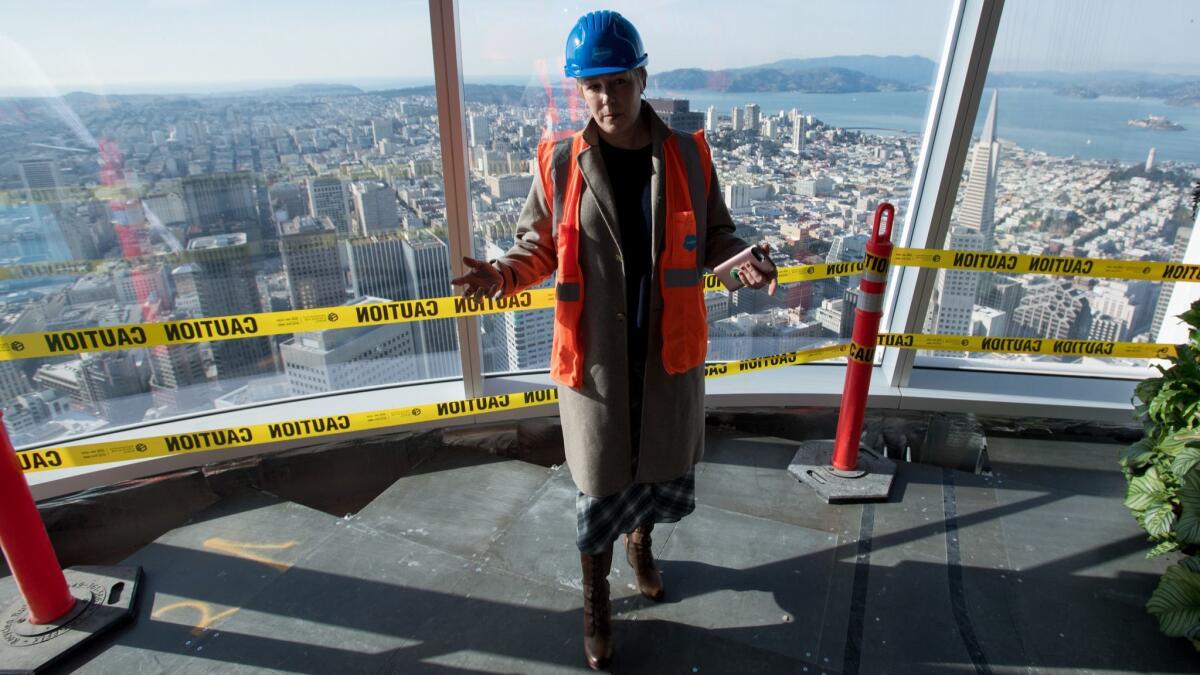
Just blocks away from Salesforce Tower are rundown buildings that have provided low-cost housing — offering single-room occupancy, or SRO, units with shared bathrooms down the hallway. Now, in a development that would’ve been unthinkable a decade ago, there are an increasing number of companies trying to buy them up and turn them into tech worker dorms, said Fernando Marti, co-director of the Council of Community Housing Organizations.
“We’re losing that housing that had been housing for last resort for a lot of folks,” Marti said. “When we see the visibility of homelessness, that’s where a lot of that is coming from.”
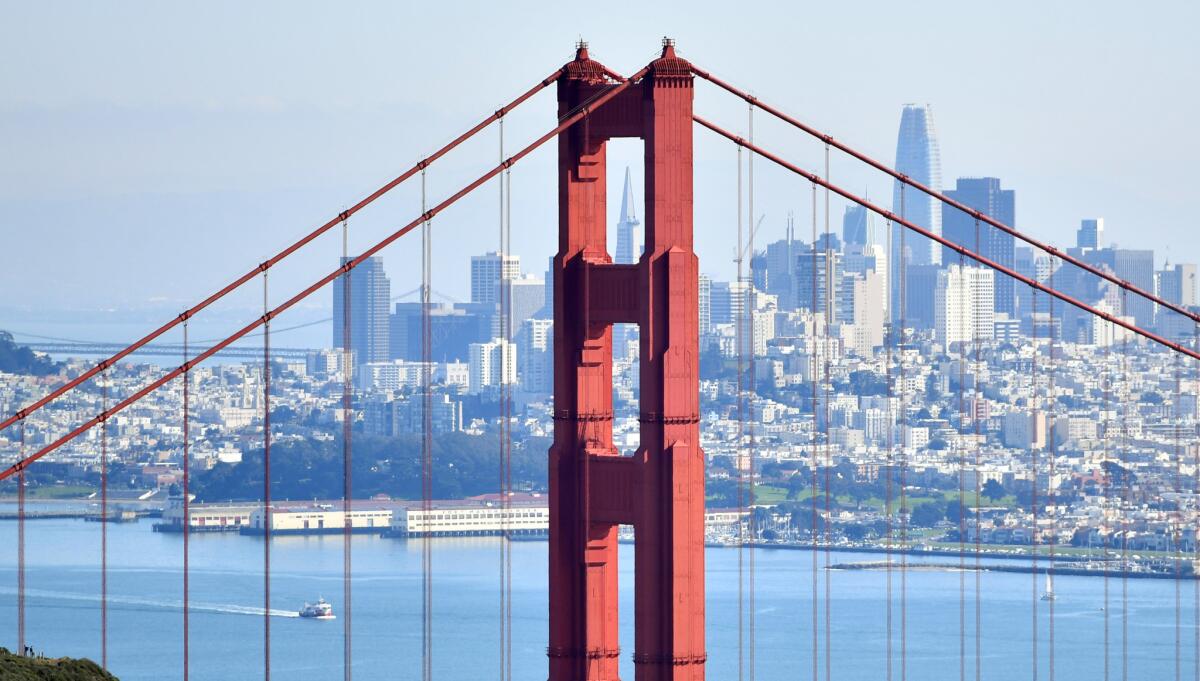
Opportunity from an eyesore
It was only eight years ago when the teardown of the hulking building that dominated South of Market, the Transbay Terminal, began.
In its heyday, the Transbay Terminal was the end of a sprawling streetcar system that linked San Francisco to Oakland by rail on the Bay Bridge’s lower deck.
But rail service ended on the bridge in 1958. The station was converted to bus use and deteriorated. Officials decided to sell 12 acres of public land to developers and use the proceeds to help pay for the new transit center.
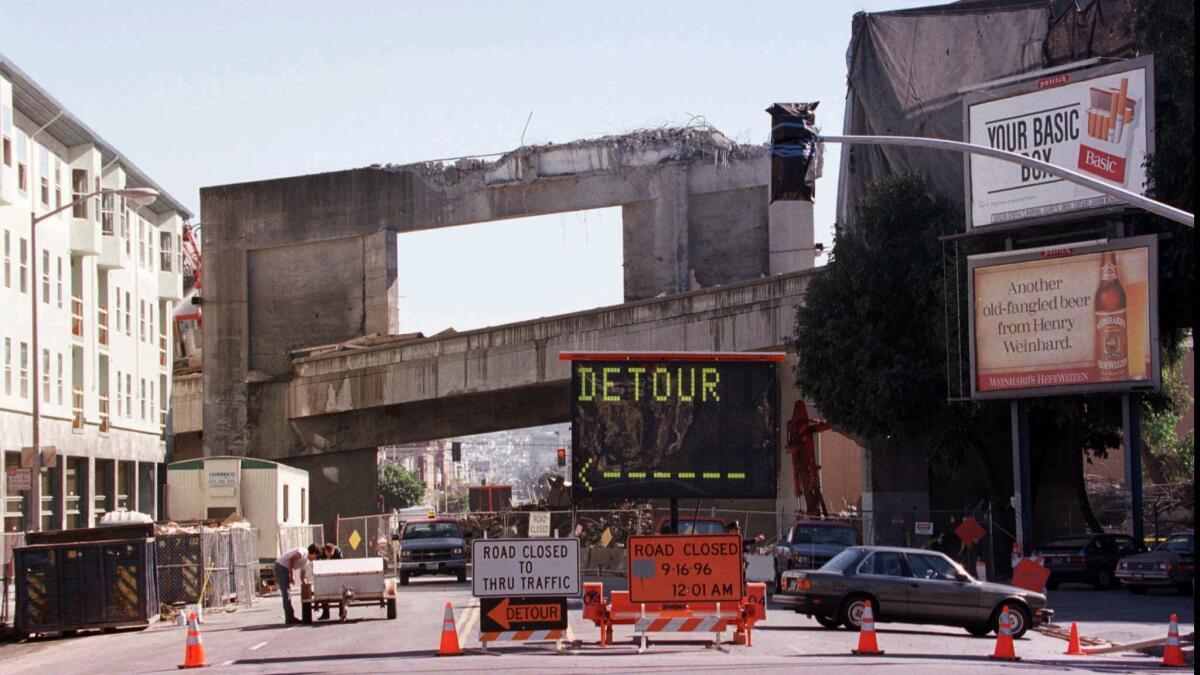
That’s what led to the 1,070-foot Salesforce Tower, soaring above even the city’s longtime tallest building, the 853-foot TransAmerica Pyramid that opened in 1972 in the Financial District.
Before the latest building boom, San Francisco’s skyline had topped out, with most of the city’s tallest buildings around the same height, said San Francisco planning director John Rahaim.
The thinking was, “let’s put the density where it matters, but let’s also not just raise up everything to a certain height,” Rahaim said. “We felt strongly that we wanted to sculpt the skyline. And when you look at the skyline from the water now, with the tower, it really is a sort of pyramidal form, with the tower being the tallest form. And if you look at a zoning map, you would see that all the height limits step down from the tower.”
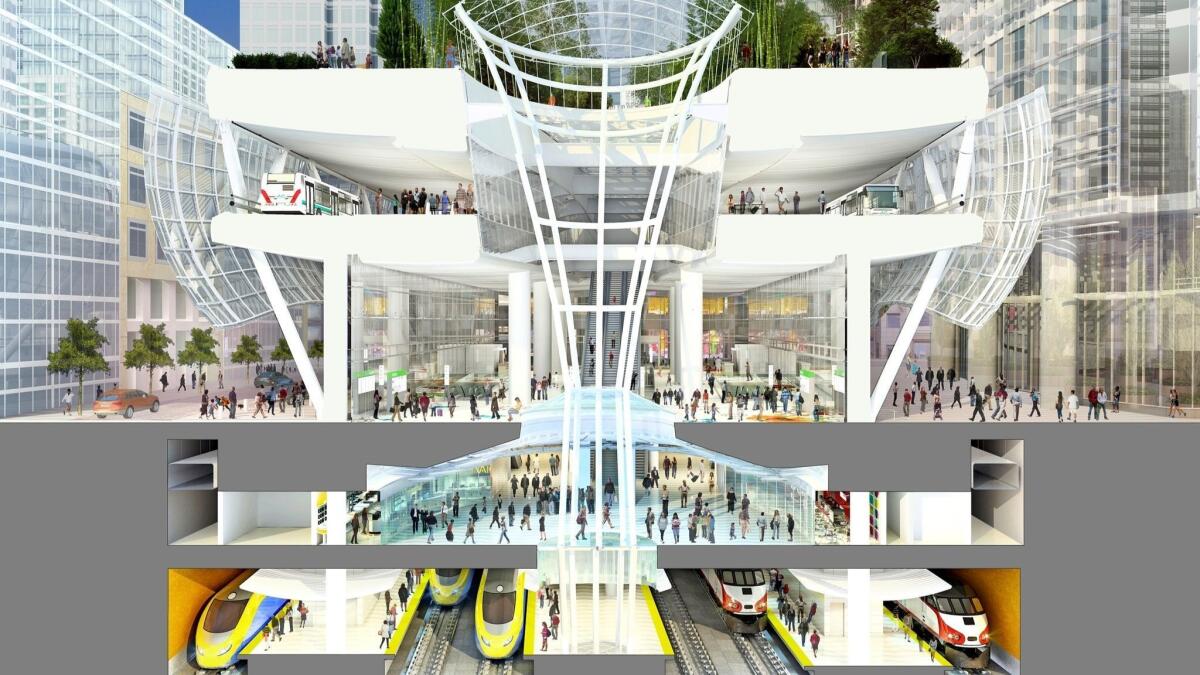
A new downtown
For decades, the South of Market area was a forgotten part of downtown — tantalizingly close to BART transbay rail service and the soaring towers of the Financial District, yet home for industry.
The decision to rid the city of the damaged Embarcadero Freeway after the earthquake prompted a re-envisioning of what the area could be. Gone was the hulking double-decker freeway that split the Ferry Building from Market Street. Buildings sprouted in its place, including what is now the worldwide headquarters of Gap Inc.
On Rincon Hill, the area where the Bay Bridge lands, the city envisioned a new residential neighborhood of high-rise buildings. Down came what had been an icon for bridge commuters: the triangular Union 76 clock tower, which in its final years became a Bank of America clock tower. In its place went up glittering residential towers.
The Transbay Terminal area was the missing piece connecting downtown and Rincon Hill.
Planners were convinced that San Francisco would need a lot more office space in the coming generation; others weren’t so sure.
“California is generally volatile in terms of demand for office space. And in the peak of the recession, there were very few tenants growing who needed space. And so the thought of adding [1.4 million] square feet to the market was visionary,” said Paul Paradis, senior managing director at Hines, the real estate company that in 2007 was picked to eventually buy the public land that would become home to what was then called the Transit Tower.
But Hines would lose its partner investor in 2012, throwing the future of the project in doubt. Coming to the rescue was Boston Properties, which joined the project, although at the time “it was a big gamble,” said Bob Pester, an executive vice president. After buying the land in 2013 and starting work on the foundation, Pester said construction could have been suspended if no one was interested in the office space.
Salesforce then came along, and in 2014 agreed to lease 32 of the building’s 61 floors.
The area has since been transformed. Close to Salesforce Tower is the 800-foot building at 181 Fremont St., San Francisco’s third-tallest tower, home to both luxury residences and offices that include Instagram, a subsidiary of Facebook. At 250 Howard St., land that was once covered by an old Transbay Terminal bus ramp is now home to Park Tower, which is under construction; all the office space in the 43-story building has been leased to Facebook, making the Menlo Park, Calif., tech giant a major employer in San Francisco.
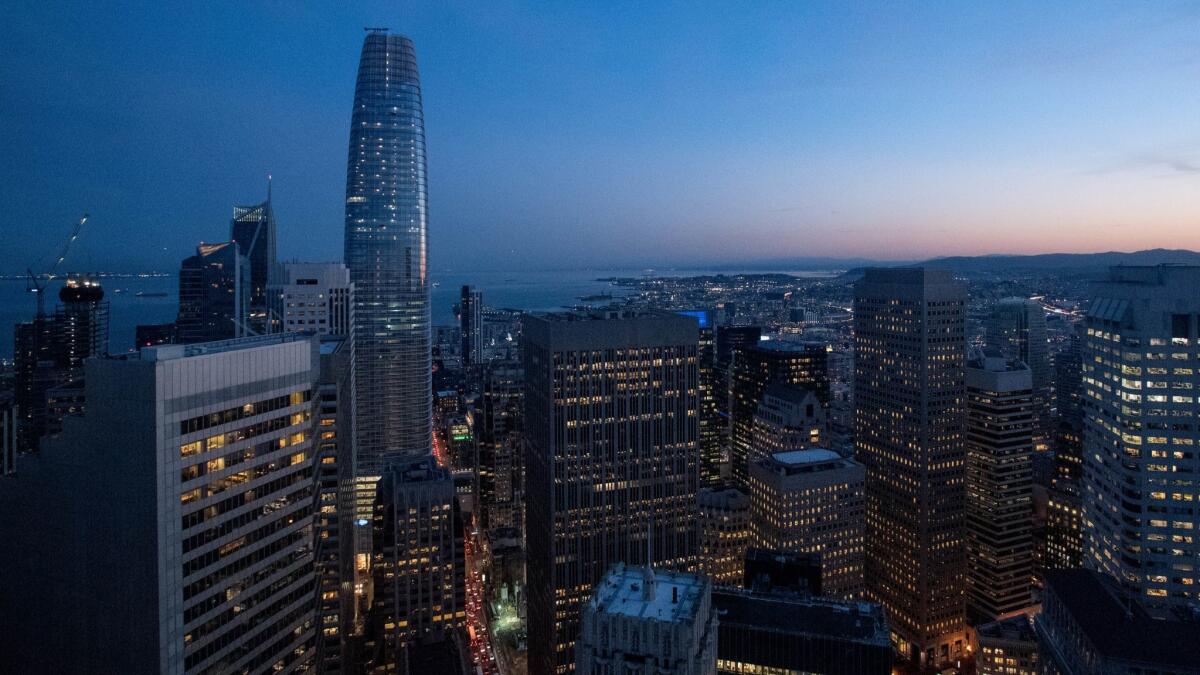
Now, it’s clear the center of gravity for downtown has moved from the Financial District south toward the tech-heavy transbay transit center area.
A decision to drill into bedrock
One aspect proudly touted by the builders of Salesforce Tower is how its foundation is firmly inside bedrock.
It’s meant to distinguish this building from the one across the street: Millennium Tower, which has sunk since construction began in 2006 and is tilting. Despite the leaning of the building, city-appointed experts have concluded the sinking has “not compromised the building’s ability to resist strong earthquakes.”
A problem for Millennium is that its foundation stretches only to a layer of sand, just above a layer of clay, instead of farther down into bedrock, said Ron Klemencic, chairman and chief executive of Magnusson Klemencic Associates, the structural engineering company for Salesforce Tower.
Such a practice was common in this part of San Francisco, where the bedrock is quite deep underneath thick layers of soft soil, sand and clay — but that was for buildings that were much shorter and lighter than Millennium, Klemencic said. (A spokesman for developer Millennium Partners, P.J. Johnston, said Millennium’s construction practices were sound, and faulted the builders of Salesforce Tower and Salesforce Transit Center for sucking water out of the soil underneath Millennium, causing the noticeable sinking.)
For Salesforce Tower, developer Hines made the decision to send the foundation into bedrock, despite the extra cost and even though that hadn’t been done in this part of San Francisco, Klemencic said.
Klemencic said he looked at 22 different earthquake scenarios to test the seismic resisting system of Salesforce Tower, which involves a reinforced concrete core at the center of the building. Because the building has a particularly high number of occupants, the tower was also designed for a higher safety standard. “It’s a more important building,” Klemencic said. “You’re obligated to make the building more safe.”
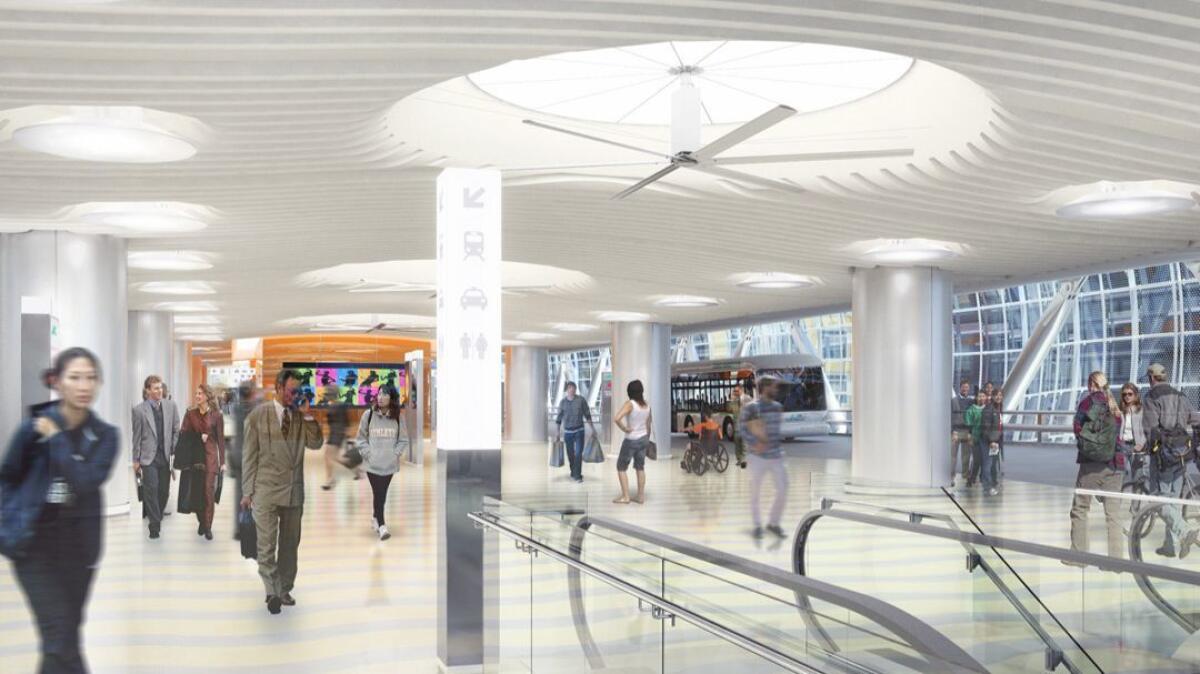
An unfinished promise
The transit center has the potential of so much more.
It’s designed to be the end of the line right now. But with talk about building a second transbay tube, “the station could be further improved and could be further extended to allow trains to go through the station” — onward to the East Bay, said Mark Zabaneh, executive director of the Transbay Joint Powers Authority.
A second transbay crossing could offer tracks for both BART and standard rail systems, which would be usable by Caltrain and high-speed rail for a route to Oakland and Sacramento. Some day, there is hope of building a block-long underground tunnel to connect the transit center to an existing BART and Muni subway station.
Challenges, however, still remain in efforts to boost public transit. After years of significant growth in ridership, Caltrain and BART have started to show declines, according to the most recent annual figures reported to the American Public Transportation Assn. Ridership is also down on bus systems that serve Alameda, Marin and San Mateo counties that offer service into the city.
On June 5, Bay Area voters backed a measure to raise tolls on state-owned bridges spanning the bay by $3 over the next seven years. The $4.5 billion in revenues will go to a variety of transit measures, with $500 million going to new BART cars, $140 million to new Muni vehicles and $325 million to extend Caltrain to downtown San Francisco.
But many more billions of dollars would be needed to get new train tracks tunneled into San Francisco’s new downtown.
The South of Market will need to continue for that vision created after the 1989 quake to be fully realized.
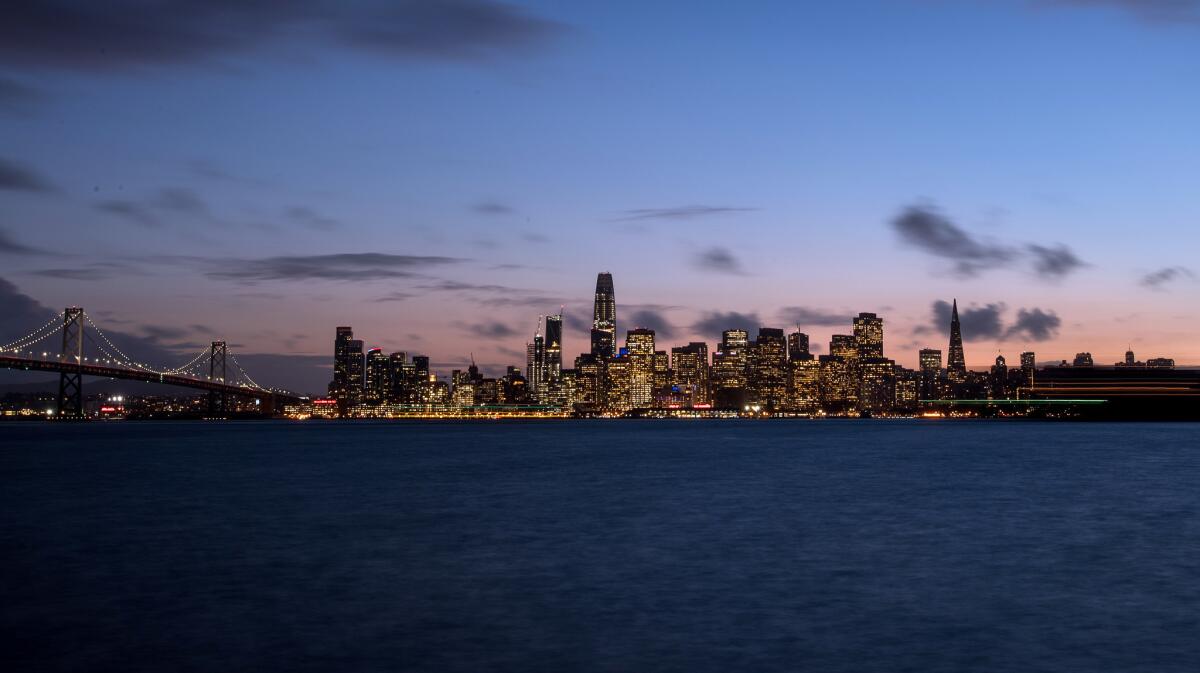
More to Read
Sign up for Essential California
The most important California stories and recommendations in your inbox every morning.
You may occasionally receive promotional content from the Los Angeles Times.
